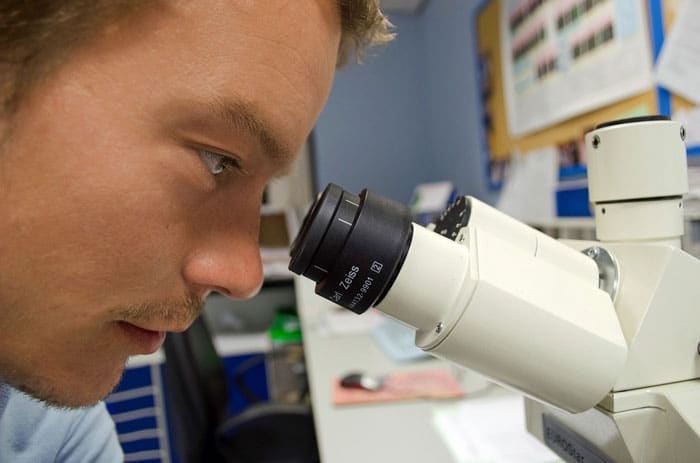
This post provides detailed information on the assistant research scientist job description, including the key duties, tasks, and responsibilities they commonly perform.
It also highlights the major requirements you may be asked to meet to be hired for the assistant research scientist role.
What Does an Assistant Research Scientist Do?
An assistant research scientist plays a critical support role in helping professors, industry researchers, and other scientists conduct studies and experiments.
This multifaceted job bridges the gap between higher level researchers, who set the direction, and technical staff, who handle routine work.
The assistant research scientist role is typically an early career position. These professionals report directly to the senior researchers or professors leading projects.
In an academic lab, this means the lab director or principal investigator.
In industry, this generally refers to the research and development director or science/engineering manager.
Assistant research scientists are employed in university laboratories, government research centers, private testing facilities, high-tech and pharmaceutical companies, chemical plants, defense contractors, electronics manufacturers, and more.
Their analytical skills are in demand across sectors.
Most assistant research scientist jobs require a Master’s degree or PhD in biology, chemistry, engineering or a relevant scientific or technical field.
Hands-on lab experience is highly valued. Some roles accept candidates with a Bachelor’s degree plus exceptional skills.
The assistant research scientist job description involves developing methodologies, conducting experiments, operating equipment, gathering and processing data, interpreting results, and documenting processes and findings.
This forms the evidence to support new inventions, innovations and published studies.
Assistant research scientists may also write segments of grants/patents, present at conferences, author academic papers, develop software and tools, design prototypes, train junior staff and students, ensure regulatory compliance, and manage portions of budgets/projects.
Mentoring future researchers is often an essential function.
Scientific advancement and cutting-edge innovations occurring in research labs across disciplines have immeasurable global significance.
The work of assistant research scientists makes these solutions and discoveries possible.
Their contributions ripple out to influence environmental policies, medical treatments, communication systems, transportation methods, safety regulations, and much more.
Employers seek assistant research scientists with critical thinking, statistics, writing, and oral presentation abilities.
Curiosity, creativity, attention to detail, and strong time management skills are equally important.
The ability to learn quickly, work independently and on teams, and persevere through failed experiments is also vital traits an assistant research scientist should have.
Assistant Research Scientist Job Description Example/Sample/Template
The assistant research scientist job description consists of the following duties, tasks, and responsibilities:
- Working alongside researchers to design and create methodologies, for studies and experiments
- Prepare laboratory instruments, equipment, and materials for conducting experiments
- Conduct independent and collaborative studies using methods
- Monitor experiments, collect data measurements, document findings and ensure results
- Analyze findings draw conclusions and derive insights from data
- Write technical reports that outline processes, techniques, materials used, observational findings, conclusions drawn and recommendations for future work
- Present research outcomes to professors, colleagues and industry partners while engaging in meaningful discussions to exchange ideas
- Conduct literature reviews to inform studies and identify areas where further investigation is needed due to knowledge gaps
- Stay up to date with the latest developments and best practices, in your specific field of expertise
- Cleanse equipment as needed while also preparing it for use. Additionally calibrate instruments regularly to maintain accuracy
- Ensure laboratory conditions and environments meet standards and controls before experiments
- Follow protocols and comply with all regulations, controls, contracts, health/safety standards, and funding requirements
- Develop graphs, charts, scientific diagrams, and other visualizations to communicate complex information
- Contribute segments to grant proposals, patents, and academic papers for vetting and publication
- Co-author articles on experiments and findings for submission to scientific journals
- Develop intellectual property with commercialization and technology transfer potential
- Train and mentor undergraduate and graduate students in the lab environment
- Supervise and guide the work of technical support staff on routine tasks
- Manage experiment schedules, recording systems, equipment budgets and laboratory inventory
- Place orders for laboratory materials, supplies, chemicals, and inventory
- Participate in scientific conferences and share experimental techniques with peer researchers
- Stay abreast of the latest published research across disciplines
- Collaborate with lab teams and external partners on interdisciplinary projects
- Develop custom software, data analysis tools, models, prototypes, and workflows to advance projects.
Assistant Research Scientist Job Description for Resume
If you have worked before as an assistant research scientist or presently working in that role and are making a new resume or CV, then you can create a compelling Professional Experience section for your resume by applying the assistant research scientist job description example above.
You can highlight the duties and responsibilities you have performed or currently carrying out as a assistant research scientist in your resume’s Professional Experience by utilizing the ones provided in the sample assistant research scientist job description above.
This will show that you have been successful performing the assistant research scientist duties, which can boost your chances of being hired or the new job that you are seeking, especially if it requires someone with some assistant research scientist work experience.
Assistant Research Scientist Requirements: Skills, Knowledge, and Abilities for Career Success
Assistant research scientists require an advanced skillset to excel. This includes specialized academic knowledge and hands-on abilities.
Many skills and are developed on the job. Key areas of expertise include:
- Technical Skills & Knowledge
- In-depth knowledge of scientific methods, principles, techniques, and instrumentation hands-on experimental skills with processes like dilution, titration, cultivation, purification, etc.
- Skills operating analytical instruments – spectrophotometers, chromatographs, EEGs, microscopes, etc.
- Understanding advanced statistics, analytics, computational modeling, and data science
- Fluency with data analysis programs, visualization software, and coding languages
- Knowledge of regulatory standards for documentation, controls, testing environments, IRB oversight, etc.
2. Communication Skills
- Science writing skills to author reports, present findings, publish papers, and contribute to patents and grants
- Oral presentation abilities to exchange ideas with teams and at scientific conferences
- Visual communication skills to design graphs, charts, diagrams, and other data visualizations
- Mentoring skills to train students and junior research assistants.
3. Critical Thinking Skills
- Design of methodologies and experimental approaches
- Attention to detail and accuracy in recording precise measurements
- Identifying knowledge gaps needing investigation
- Interpreting findings, forming conclusions, and applying insights
- Identifying opportunities for commercialization and technology transfer.
4. Management Skills
- Time management and organizational skills to juggle multiple experiments
- Resource management abilities over lab budgets, supplies, chemicals, and more
- Skills training, scheduling, guiding the work of support staff and students.
Assistant Research Scientist Salary
The average yearly wage for assistant research scientists was $64,310 in May of last year (2022) based on the U.S. Bureau of Labor Statistics.
The top 10% brought home over 100k while the bottom 10% made less than $44,370.
The highest paying states were:
- Washington D.C. at $85,150
- California at $79,440
- Maryland at $70,660
- Massachusetts at $66,480
- Virginia at $65,850.
Conclusion
Assistant research scientists are indispensable engines helping drive innovation. As this article illuminated, their job description entails operating behind the scenes designing experiments, gathering data, interpreting results, and documenting processes.
Their evidence-based contributions provide the foundation for published studies, groundbreaking discoveries, and technological advances that shape the future.
It’s a complex role requiring deep technical expertise, scientific creativity, and a diverse set of soft skills.
Assistant research scientists have to manage details while comprehending the big picture. They balance independence with strong collaborative abilities.
Each day presents new intellectual challenges and opportunities for breakthroughs.
For those intrigued by careers grounded in science, the assistant research scientist path promises lifelong learning, cutting-edge communities, the joy of inquiry, and work that matters.
Employers across every industry sector seek out these agile, analytical, meticulous research professionals.
And the field offers ample room for specialization, advancement, and global mobility.
Whether you’re a student contemplating majors, a young graduate seeking direction, a scientist wanting to advance, or an employer looking to add research firepower, this article presented all the key details about assistant research scientist duties and responsibilities.
It’s a career brimming with daily discoveries and immense possibilities to create lasting positive impact.
The future of innovation depends on the curiosity that drives these professionals forward.












